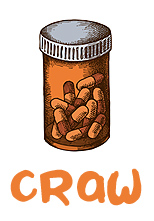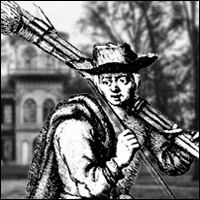Ishmael, before we get into how we defend ourselves with a knife held in a reverse grip we must establish why and, in so doing, establish what type of knife.
Material
As T. E. Mails illuminated in his great book, Mystic Warriors of the Plains, the Native American who fought with a knife originally did so in a reverse grip because his fighting knife was likely made of horn. Stone and obsidian would be too brittle for combat and were used for skinning and butchering. The reverse grip allows the fighter to "hammer" home the knife.
As a stone age mind, stuck in a modern body, marooned in postmodern Time, I have chosen the reverse grip for material reasons of my own:
-I must use a small pocketable knife which will not be noticed by the police.
-I cannot reliably open folding knives, because of the seven breaks and innumerable sprains to my knife hand.
-Using a small knife in close quarters is likely to result in my being disarmed, due primarily to my thumb being damaged on contact.
If I have a bowie knife, I'm never reversing the grip but using it like a short sword.
If I have a butcher, filleting or other kitchen knife I will not use the reverse grip, as such flimsy blades often end up slapping from the reverse grip, as seen in the Islamic Mall Attack earlier this year.
Tactical
-I will have to deploy a knife after action has been initiated against me, which makes any small motor stuff dicey and begs for a reduced weapon size for quickness of deployment.
-I will only draw a knife against multiple aggressors. There are two dangers to the knifer in this scenario 1.) That I cut or stab one and the other sees this and jumps back, becoming a witness to my unprovoked knife attack, 2.) Most successful knife disarms are by groups, with one or more holding the knifer and another person prying the knife loose. The reverse grip with a short knife is the most difficult blade to see, and the most difficult blade to disarm.
-Up until six months ago my knife-fighting mobility was still such that I could carve up most experienced knife duelists half my age, most of the time. With my hip injury this game evaporates. I will no longer have the option to launch myself like a weapon and stab a dude from six feet and spring back out or danger like a monkey. This means I will be operating in the same tactical environment as the Native American and the modern special operations soldier armed with a knife, in a grappling, sentry-removal situation. This is not a good grip—or even functional—against a trained saber grip or hammer grip knife man. However, such men are not out there robbing and attacking people. You will not be attacked by a trained knifer. If he has a knife this aggressive grip will be adequate to take him out. Most likely he and his friend do not have a knife. If there are three, one of them will have a knife, which gives even more tactical purpose to hiding and using your knife close. You are better off if the unskilled knifer thinks you are unarmed. This way he may get too close for his own good.
-I travel in a gun-rich environment, and have no desire to advertised that I am armed with a knife and thus become the proverbial asshole who brought a knife to a gun fight.
-The three most powerful knife strokes—though of very limited range—are reverse grip strokes. I want to drop assailants in one stroke, so need what is equivalent to a sword stroke. Sword strokes delivered for demonstration purposes stroke with the "sweet spot" of the blade where the "fort" and "foible" of the blade meet. However, when dueling with steel, you tend to stroke with the foible, the end portion of the blade. By stabbing into a person and then rip-cutting out with a 2-3 inch blade, you are essentially delivering a machete stroke. You will be close and therefore could stab many times quickly. However, people tend to remain combative after numerous shallow stabs. Also, murderers, especially in prison, tend to use multiple stabs and you do not want to be confused with those psychos.
-Finally, this was the knife I had left to me when I surveyed my arsenal and discovered that I could not open folding knives with posts even, reliably, with my one hand. The knife in question is the neck knife, which you explained to me was worn on a neck lariat and drawn to skin an animal as you hurry to butcher the animal before that grisly bear comes to eat his fill.
This knife is in a CRKT pressure sheath, is forged of one piece of steel by ACHI, in the Burnely design, has a 2.5 inch camo, single-edged blade and a 3.5 inch rubber-dipped, paracord wrapped hilt. This small utility knife is pure practicality. I will explain how to utilize this blade as a combat weapon in the next installment, including the rigging system I worked out.
Thank you, Ishmael, for mailing this blade to me, for I have already drawn it in my own defense thrice, and on one occasion, I think it might have made the difference between me being scared—as I was—or stabbed and stomped into a coma [or possibly shot] as I may well have been by those three large men who were piling out of the car that cut me off, only to stop when they noticed that something was in my right hand, which remained unseen, covered as it was by my left hand.
Thriving in Bad Places











